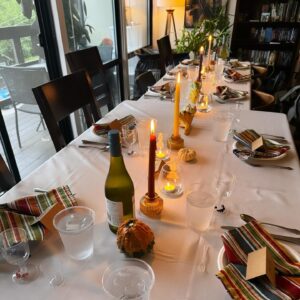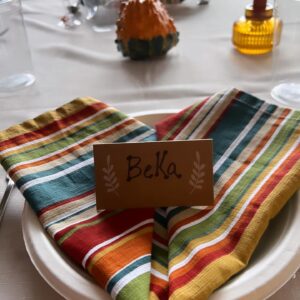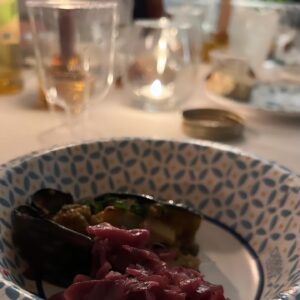I was first introduced to the book Supper of the Lamb by Robert Farrar Capon sometime in 2010 and immediately loved it. If you’re unfamiliar, it’s a book of culinary reflections and recipes written by an Episcopalian priest, and it is delightful. I’ve gifted this book to many people and forced it upon a number of book clubs throughout the years, with varying degrees of reception.
Many times, I’ve thought about how enjoyable it would be to host a dinner and discussion filled with recipes and themes from and/or inspired by the book, but it wasn’t until I joined an Anglican church that I realized I had found my people—I knew these people would be up for this sort of event before we ever asked them. So I pitched the idea to our director of parish life, and her reaction did not disappoint. I’m pretty sure her eyes lit right up, and a huge smile formed across her face.
She quickly looped in one other parishioner, a fellow Capon fan and co-collaborator on the faith + film event we did in September, to help with planning and hosting. The three of us immediately got to work scheming up one amazing evening. What follows is just a taste of the magic—what little of it we could document while trying to remain present in the moment.
The ask
Most people who coordinate events for churches will tell you to never do what we did. We asked a lot of the people who wanted to attend. When we put out the signup sheet in the newsletter and bulletin, we indicated attendees would have to do all of the following to participate in this event:
- Read the book
- Make a course
- Plate & present the course
- Facilitate a short discussion
You couldn’t sit on the sidelines or just show up. You had to be all in. We knew that would narrow the registration list, but we also all agreed it was necessary for the event to actually work as we intended it to. So that was the ask, and amazingly, 14 people signed up! We assumed we’d get about eight (which is perfect for a dinner party)—14 was a pleasant surprise. We had thought about splitting the group into two groups of seven, but we ultimately decided to try to get everyone together in one place. And since we had more than eight people, we divided some of the courses up into multiple parts to make sure everyone had a way to contribute.
The themes
While the registration list was circulating, we were busy finalizing the courses and suggested menu items. We also worked to pair those courses with themes from the book, so each person would have a starting point for discussion.
- Hors d’oeuvre: Tasting & seeing
- Amuse-bouche: Imago dei
- Bread: Knives
- Soup: Living water
- Salad: Paying attention
- Main course: The whole burnt offering
- Cheese: Fasting & feasting
- Dessert: Thrifty idolatries
The big night
In the week leading up to the event, I watched Big Night and Babette’s Feast, which were such great films to watch on a week like this. I found myself thinking about both of these films as we prepared and throughout the dinner itself. I highly recommend taking in additional perspectives when planning an event like this. It gives you so much more to pull from in the moment when you’re there taking in all of the incredible conversations and connecting dots in your head and out loud with your fellow culinary adventurers.
Below you can see photos of the table and place settings. We ended up creating one long table for eleven guests (three couldn’t make it). If you’re noticing the creases in the tablecloths—that’s because none of us owned an iron (more proof these are my people)! We did try using a steamer, but I’m going to just call this a miss on our part. Something to think about in advance next time.
You’ll also notice lots of paper and plasticware, which is not ideal. But we needed to be able to clean up very quickly and get home at a decent hour since almost all of us had to be at church early for setup the next morning. So, we made a few compromises for the sake of efficiency and sanity.
While some were surprised by the decision to host so many people in such a small space, we actually think entertaining everyone in a smaller space contributed to the intimacy of the evening and helped facilitate better relationship-building and conversation. After all, while we all have our church in common, we’re still very different people from a variety of backgrounds and cultures. We need moments like this to stretch us and help us break out of our comfort zones. You’ll also notice the place cards. We intentionally mixed people up a bit and tried to encourage people who may not know each other as well to get to know one another better.
The liturgy
It was important to us that this evening be drenched in prayer, thanksgiving, contemplation, and praise. We opened with prayer and sang the doxology (I love how this is a fairly normal thing to do before meals in this community). And we ended the evening with a time of reflection, singing For Thine Is the Kingdom, and closing with a reading from the Book of Common Prayer:
Lord Jesus, stay with us, for evening is at hand and the day is past; be our companion in the way, kindle our hearts, and awaken hope, that we may know you as you are revealed in Scripture and the breaking of bread. Grant this for the sake of your love. Amen.
The courses
In closing, I’ll walk through each course one by one and share some of the quotes we provided for consideration. It would be too much to try to document all of the things that were discussed, but I walked away incredibly thankful and enriched by the experience. So many thoughtful conversations I’ll be thinking about for weeks to come.
One | Hors d’oeuvre: Tasting & seeing
Course one was Swedish meatballs garnished with fresh rosemary and a bit of homemade plum jam. It was paired with this orange wine.
Quotes for consideration
“To be sure, food keeps us alive, but that is only its smallest and most temporary work. Its eternal purpose is to furnish our sensibilities against the day when we shall sit down at the heavenly banquet and see how gracious the Lord is. Nourishment is necessary only for a while; what we shall need forever is taste.”
“Our daily renewed astonishment at things as they are can save us from idols; it is our love of real processes and actual beings that keeps us sane… Fancy cooking and plain eating is as good for your taste as it is for your soul.”
Two | Amuse-bouche: Imago dei
Course two was arugula, roasted beets, goat cheese, and pistachios, and it was paired with the Sauvignon Blanc below.
Quote for consideration
“Why do we marry, why take friends and lovers, why give ourselves to music, painting, chemistry, or cooking? Out of simple delight in the resident goodness of creation, of course; but out of more than that, too. Half of Earth’s gorgeousness lies hidden in the glimpsed city it longs to become. For all its rooted loveliness, the world is no continuing city here; it is an outlandish place, a foreign home, a session in via to a better version of itself—and it is our glory to see it so and thirst until Jerusalem comes home at last. We’re given appetites not to consume the world and forget it, but to taste its goodness and hunger to make it great. That’s the unconsolable heartburn, the lifelong disquietude of having been made in the image of God.”
Three | Bread: Knives
The third course was homemade bread, butter, and a bite of cheese. We didn’t add any additional wines to the table for this course, but many finished up some of the wines left from the first two courses.
Quotes for consideration
“Any knife that will not cut hot bread is not a bread knife at all. If it will not let you have bread at its best, how can it be worthy of the name?”
“Whatever you do, therefore, don’t omit the final grace—the loving pat of butter.”
Four | Soup: Living water
The fourth course was potato soup (the exact recipe from the book) and sparkling water. I originally wanted this course to simply be bone broth, but I was overruled. I’m glad I was overruled—the potato soup was so good. Some people decided to hold on to their bread to dip in the soup so courses three and four blended together a bit.
Quote for consideration
“Admittedly, the Scriptures begin and end with water. There is a river in Eden, and there is a river in the Heavenly Jerusalem: All life comes from the sea. Equally certainly, without water, no life is possible in between. No man can praise it enough. It is the root of freshness, the sign of purity, the means of grace…But for all that, plain water is not the world’s best gift to a stew. What is needed in cooking is living water, water elated to new eminences, water transformed into stock.”
Five | Salad: Paying attention
Course five included two warm salads (of sorts): eggplant provençale and red cabbage with onions. Both recipes were directly from the book with only one slight alteration. Both were excellent.
Quotes for consideration
“You are convinced, of course, you know what an onion is. You think perhaps that it is a brownish-yellow vegetable, basically spherical in shape, composed of fundamentally similar layers. All such prejudices should be abandoned. It is what it is, and your work here is to find it out.”
“Between the onion and the parsley, therefore, I shall give the summation of my case for paying attention. Man’s real work is to look at the things of the world and to love them for what they are. That is, after all, what God does, and man was not made in God’s image for nothing.”
Six | Main course: The whole burnt offering
The sixth course was the main event: the lamb. It was perfectly prepared by our host and paired with two choices of wine, both from the Orcas Project, a Tempranillo and a Cabernet Franc. The lamb was also meant to be served on a bed of garlic mashed potatoes, but we won’t talk about that. Nope.
Quotes for consideration
“Man not only dines—he kills and sacrifices…Man is not simply gourmet, he is carnivore and offerer as well. No matter that we are able to ignore his butchering by specialization and his priesthood by sophistication. Our home ground remains what it always has been: bloody ground and holy ground. Inattention explains nothing.”
“Sacrifice therefore, not written off, but recognized, a sign in blood of the vaster end of blood; a redness turning all things white; an impossibility prefiguring the last exchange of all.”
Seven | Cheese: Fasting & feasting
The seventh course included four cheeses (from top to bottom):
- Gouda from Appel Farms, Ferndale, Washington
- Smoked Gruyere from Red Apple Cheese, Wisconsin
- Smoked goat from Sierra Nevada, Willows, California
- Aged sheep milk cheese from Ewephoria, Cheeseland, Holland
The cheeses were paired with a marmalade, apple butter, and port.
Quotes for consideration
“Remember, calories are only demons to be exorcized.”
“Deliver us, O Lord, from religiosity and Godlessness alike, lest we wander in fakery or die of boredom. Now we may drink.”
Eight | Dessert: Thrifty idolatries
The eighth and final course was the dessert course, with a couple of options. The first was a dark chocolate oat milk pudding with whipped cream and berries. The second was a 33-layer pistachio baklava. We poured coffee, tea, merlot, and Bailey’s.
Quotes for consideration
“First, it’s an honest attempt to create a company, not a crowd. Persons matter at the table… Nowhere more than in good and formal company do we catch the…foretaste of what is in store for us… The dinner party is the true proclamation of the abundance of being—a rebuke to the thrifty little idolatries by which we lose sight of the lavish hand that made us. It is precisely because no one needs soup, fish, meat, salad, cheese, and dessert all at one meal that we so badly need to sit down to them from time to time.”


















